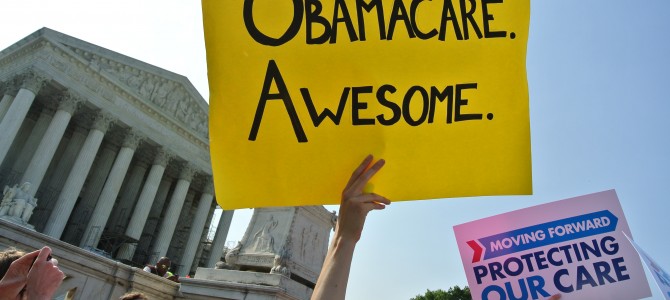Fast on the heels of the Halbig and King decisions this week, in which the D.C. and Fourth Circuit courts split over whether subsidies can be disbursed through federal exchanges (not just state-based exchanges, as the law stipulates), comes two studies that, taken together, cast doubt on entire exchange scheme of Obamacare.
The first study, published Wednesday by the New England Journal of Medicine (NEJM), initially appears to be a cause for celebration among Obamacare supporters: it found the law has helped insure more than 10 million people since last October, when the exchanges began open enrollment. Researchers estimate that the uninsured rate dropped by more than 5 percentage points in the second quarter of this year as a result of expanded coverage under Obamacare, declining from 21 percent in September 2013 to 16.3 percent in April 2014.
As you can imagine, states that expanded Medicaid saw the largest drop in their uninsured rates—6 percent compared to a 3 percent drop in states that didn’t expand. The study, which used Gallup polling and U.S. Department of Health and Human Services data, mirrored findings by Gallup (obviously) and estimates from the Congressional Budget Office.
Who Cares If You’re Legal
But another report published Wednesday cast the findings of the NEJM study in a less favorable light. The Government Accountability Office (GAO) released the preliminary results of an investigation into fraud on the Obamacare exchanges, and found, among other things, that 11 out of 12 fake applicants were able to get subsidized coverage on the exchanges—about a 91 percent success rate, if by “success” you mean fraudulently gaining subsidized coverage.
Those 11 fake applicants—that is, applications with falsified documentation—were all required to submit supporting documents to verify eligibility. But the submission and review process was inconsistent, GAO found, and there was also this:
As of July 2014, GAO had received notification that portions of the fake documentation sent for two enrollees had been verified. According to CMS, its document processing contractor is not required to authenticate documentation; the contractor told us it does not seek to detect fraud and accepts documents as authentic unless there are obvious alterations. As of July 2014, GAO continues to receive subsidized coverage for the 11 applications, including 3 applications where GAO did not provide any requested supporting documents.
Isn’t that nice? Keep in mind the entire point of this GAO investigation is to test the “front-end” controls that the Centers for Medicare & Medicaid Services (CMS) claims are in place to prevent fraud and ensure that only those who are eligible actually receive subsidies.
Navigating the System
The GAO investigation also tried to discover whether in-person assisters, or “navigators,” would urge applicants to lie about their income in order to get subsidies, as was documented among Texas navigators last year by James O’Keefe. Investigators couldn’t actually get anyone to assist them, but numerous reports on navigators have revealed questionable tactics that come close to fraud and political activity.
Most recently, National Review Online’s Jillian Kay Melchior wrote a piece about a navigator in Connecticut, Linda Yannone, who pursued her work in that capacity for the sake of social justice. “That’s not a political agenda,” Yannone said. “I mean, I don’t even know what a political agenda is. It’s injustice to have people losing their homes and being stuck in terrible jobs that they hate, just because of insurance, or terrible relationships, abusive relationships, because of lack of health care.” While working as a navigator, she sent around an email to her co-workers stating that “the capitalism of health care is simply inappropriate and untenable” and urging them to sign a MoveOn.org petition that read:
The People’s health is a matter of public safety and a basic human right. It is not an optional commodity to be capitalism-ized and tossed into the marketplace for gambling and profiteering. Rather, it is like the FDA, roads, national defense, etc., to be supported by taxes. Therefore, please introduce National Health Care with a single payer system, aka ‘Medicare for all.’
Yannone claimed to have enrolled 1,100 people in coverage through the Connecticut exchange.
Of course, none of this proves anything. In fact, a GAO official told the House Ways and Means Oversight subcommittee that the results of the probe are not enough to draw conclusions about widespread fraud on the exchanges. And one bad navigator in Connecticut, or handful in Texas, does not a conspiracy make.
But at the very least the GAO report, along with media reports, casts serious doubt on the notion that everyone gaining coverage on the exchanges is actually eligible. That, in turn, casts doubt on whether the uninsured rate has dropped as much as the NEJM study says it has.
And all this, taken in hand with the Halbig ruling, casts doubt on whether the Obama administration really thought out how the Affordable Care Act would work, or whether it work at all, or whether that was really a priority in passing the law in the first place.
Follow John Davidson on Twitter.









